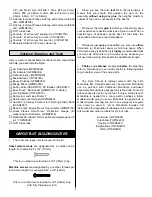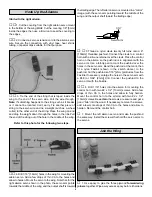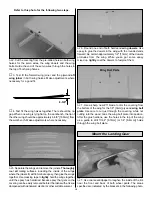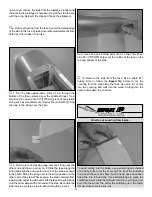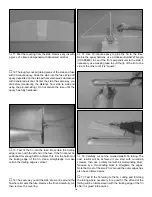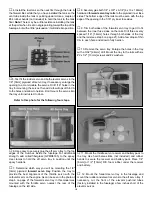
1. If you have not done so already, remove the major parts
of the kit from the box (wings, fuse, wheel pants, cowl, tail
parts, etc.) and inspect them for damage. If any parts are
damaged or missing, contact Product Support at the
address or telephone number listed on page 6.
2. Remove the masking tape and separate the ailerons from
the wing, the rudder from the fin, and the elevators from the
stab. If necessary, use a covering iron with a covering sock
on high heat to tighten the covering. Apply pressure over
sheeted areas to thoroughly bond the covering to the
wood. Hint: Poke three or four pin holes in the covering
between the “ribs” in the tail surfaces and ailerons. This will
allow air to escape to fully tighten the covering.
Do the right aileron first.
❏ ❏
1. Locate the hinge slots in the right wing and the right
aileron. Cut a small strip of covering from each slot.
❏ ❏
2. Drill a 3/32" [2.4mm] hole 1/2" [13mm] deep in the
center of the slots. For the best result, use a high-speed tool
such as a Dremel. Insert a #11 knife blade into the slots,
working it back and forth a few times to clean the slots out.
❏ ❏
3. Cut four 3/4" x 1" [19 x 25mm] hinges from the
supplied CA hinge strip.
❏ ❏
4. Test fit the aileron to the wing with the hinges. If the
hinge slots are too tight, remove the hinges and use a #11
blade to slightly open the slots. If necessary, insert a pin
through the center of the hinges so they remain centered
when joining the aileron to the wing.
❏ ❏
5. With the aileron joined to the wing, remove any pins
used to center the hinges. Be certain there is a small gap
between the leading edge of the aileron and the wing–just
enough to slip a piece of paper through or to see light through.
❏ ❏
6. Apply six drops of thin CA to both sides of all the
hinges. Wait a few seconds between drops to allow the
hinge slots to fully absorb the CA.
❏
7. Join the left aileron to the left wing panel the same way.
THIN
CA
1"
1"
3/4"
DRILL A 3/32" HOLE
1/2" DEEP, IN CENTER
OF HINGE SLOT
AWAY FROM THE SLOT
CUT THE COVERING
Hinge the Ailerons
ASSEMBLE THE WING
TIGHTEN THE COVERING
8





